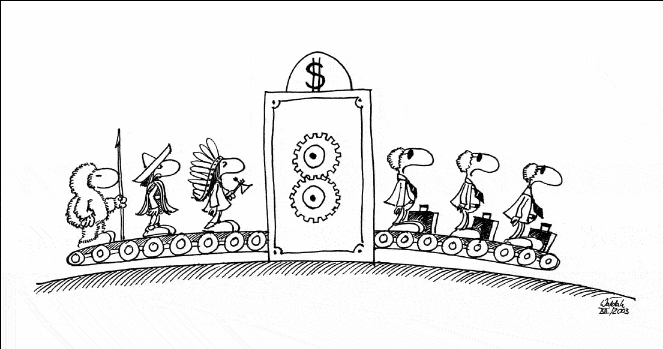by JOHN BELLAMY FOSTER

There is a shadow of something colossal and menacing that even now is beginning to fall across the land. Call it the shadow of an oligarchy, if you will; it is the nearest I dare approximate it. What its nature may be I refuse to imagine. But what I wanted to say was this: You are in a perilous position.
Jack London, The Iron Heel1
Not only a new administration, but a new ideology has now taken up residence at the White House: neofascism. It resembles in certain ways the classical fascism of Italy and Germany in the 1920s and ’30s, but with historically distinct features specific to the political economy and culture of the United States in the opening decades of the twenty-first century. This neofascism characterizes, in my assessment, the president and his closest advisers, and some of the key figures in his cabinet.2 From a broader sociological perspective, it reflects the electoral bases, class constituencies and alignments, and racist, xenophobic nationalism that brought Donald Trump into office. Neofascist discourse and political practice are now evident every day in virulent attacks on the racially oppressed, immigrants, women, LBGTQ people, environmentalists, and workers. These have been accompanied by a sustained campaign to bring the judiciary, governmental employees, the military and intelligence agencies, and the press into line with this new ideology and political reality.
Who forms the social base of the neofascist phenomenon? As a Gallup analysis and CNN exit polls have demonstrated, Trump’s electoral support came mainly from the intermediate strata of the population, i.e., from the lower middle class and privileged sections of the working class, primarily those with annual household incomes above the median level of around $56,000. Trump received a plurality of votes among those with incomes between $50,000 and $200,000 a year, especially in the $50,000 to $99,999 range, and among those without college degrees. Of those who reported that their financial situation was worse than four years earlier, Trump won fully 77 percent of the vote.3 An analysis by Jonathan Rothwell and Pablo Diego-Rosell of Gallup, updated just days before the election, indicated that in contrast to standard Republican voters, much of Trump’s strongest support came from relatively privileged white male workers within “skilled blue collar industries”—including “production, construction, installation, maintenance, and repair, and transportation”—earning more than the median income, and over the age of forty.4 In the so-called Rust Belt 5 states (Iowa, Michigan, Ohio, Pennsylvania, and Wisconsin) that swung the election to Trump, the Republican vote increased by over 300,000 among voters earning $50,000 or less, as compared with 2012. Meanwhile, among the same demographic group, Democrats lost more than three times as many voters as the number Republicans gained.5 None of this was enough to win Trump the national popular vote, which he lost by almost 3 million, but it gave him the edge he needed in the electoral college.
Nationally, Trump won the white vote and the male vote by decisive margins, and had his strongest support among rural voters. Both religious Protestants and Catholics favored the Republican presidential candidate, but his greatest support of all (80 percent) came from white evangelical Christians. Veterans also went disproportionately for Trump. Among those who considered immigration the nation’s most pressing issue, Trump, according to CNN exit polls, received 64 percent of the vote; among those who ranked terrorism as the number-one issue, 57 percent.6 Much of the election was dominated by both overt and indirect expressions of racism, emanating not only from the Republican nominee but also from his close associates and family (and hardly nonexistent among the Democrats themselves). Donald Trump, Jr., in what was clearly a political ploy, repeatedly tweeted Nazi-style white supremacist slogans aimed at the far right. Trump’s only slightly more veiled statements against Muslims and Mexicans, and his alliance with Breitbart, pointed in the same direction.7
As the Gallup report pointedly observed:
In a study [Richard F. Hamilton, Who Voted for Hitler?] of perhaps the most infamous [nationalist] party, the geography of voting patterns reveal that the political supporters of Hitler’s National Socialist party were disproportionately Protestants, if living in a rural area, and those in lower-middle administrative occupations and owners of small businesses, if living in an urban area. Thus, neither the rich nor poor were especially inclined to support the Nazi Party, and even among Christians, religious identity mattered greatly.8
The clear implication was that Trump’s supporters conformed to the same general pattern. According to the Hamilton study, it is generally believed that “the lower middle class (or petty bourgeoisie) provided the decisive support for Hitler and his party.”9 Hitler also drew on a minority of the working class, disproportionately represented by more privileged blue-collar workers. But the great bulk of his support came from the lower middle class or petty bourgeoisie, representing a staunchly anti-working class, racist, and anti-establishment outlook—which nevertheless aligned itself with capital. Hitler also received backing from devout Protestants, rural voters, disabled veterans, and older voters or pensioners.10
Monthly Review Online for more
